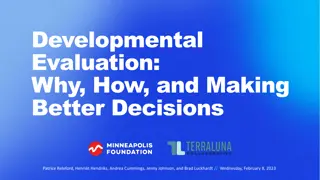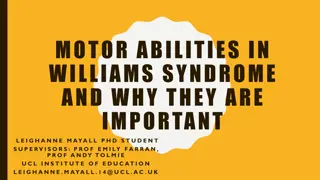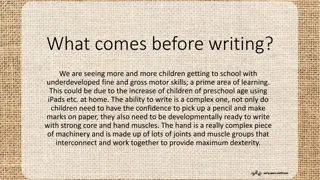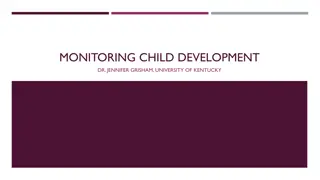Effective Strategies for Children with Developmental Language Disorder, Sensory Processing Disorder, and Fine Motor Delays
Children with Developmental Language Disorder (DLD), Sensory Processing Disorder (SPD), and Fine Motor Delays often have accompanying sensory and fine motor deficits. Research indicates that addressing sensory processing deficits can significantly benefit children with DLD, ADHD, autism, and other developmental conditions. Understanding the foundational principles and nature of SPD, utilizing sensory diets, and integrating therapy activities can help improve language, sensory processing, and fine motor skills in these children.
- Developmental Language Disorder
- Sensory Processing Disorder
- Fine Motor Delays
- Therapy Strategies
- Child Development
Download Presentation

Please find below an Image/Link to download the presentation.
The content on the website is provided AS IS for your information and personal use only. It may not be sold, licensed, or shared on other websites without obtaining consent from the author. Download presentation by click this link. If you encounter any issues during the download, it is possible that the publisher has removed the file from their server.
E N D
Presentation Transcript
Specific Strategies for Children with Developmental Language Disorder, Sensory Processing Disorder, and Fine Motor Delays
I. Introduction and Background** II. Foundational Principles and Nature of SPD III. Eight Sensory Systems IV. Implications for Speech and Language V. Sensory Diet VI. Specific Therapy Materials and Activities for Integrating Language, Sensory, and Fine Motor Skills
I. Introduction and Background** My personal interest in Sensory Processing Disorder: My son Mark was diagnosed with SPD, dyslexia, and ADHD
II. Foundational Principles and Nature of SPD** It is increasingly being found that children with special needs such as Developmental Language Disorder (DLD) and Autism Spectrum Disorder (ASD) have accompanying sensory and fine motor deficits
Research over the years has clearly shown** that sensory processing deficits, often described under the term sensory processing disorder (SPD), are a co-morbid problem that can accompany childhood apraxia of speech, autism spectrum disorder, attention deficit hyperactivity disorder (ADHD), and DLD
Sensory Integration Dysfunction/Sensory Processing Disorder** An irregularity or disorder in brain function that makes it difficult to integrate sensory input effectively Consequences may appear in the areas of: Motor learning Social/Emotional components Speech/Language components Attention Disorders
STAR Institute, 2024:** Pioneering occupational therapist, psychologist, and neuroscientist A. Jean Ayres, Ph.D., likened SPD to a neurological traffic jam that prevents certain parts of the brain from receiving the information needed to interpret sensory information correctly.
Possible Causes of SI Dysfunction** Prematurity Birth Trauma Drug/Alcohol Exposure Infections/Viruses Genetics Environment Neurological Unknown
2024 Journal of the American Medical Association https://jamanetwork.com/journals/jamapediatrics/ar ticle-abstract/2813443** Analyzed data for 1471 children (# of children not on the test) They studied screen-viewing data for the group at 12, 18, and 24 months old At 33 months old, assessed children s sensory processing
In the JAMA 2024 study, they studied atypical sensory behaviors such as:
Proprioception:** Body's ability to sense movement, action, and location Examples: being able to walk or kick without looking at your feet; being able touch your nose with your eyes closed Difficulties occur when there is a reduction in the sense that tells the body where you are in space (e.g., Mark would bump into other children)
IV. Implications for Speech and Language** Communication is a result of our (sensory) experiences learning to communicate by hearing, seeing, touching, and moving about the world . . . . . There is a reciprocal relationship among sensory experiences and language. If language is a system of symbols/words used represent concepts that are formed by exposure and experience, then a well integrated sensory system will help children learn words more readily.
Mixed Response** Many people with ASD have both over- responsivity in some systems and under- responsivity in other systems Common ASD pattern: over-responsive to far sensory systems and under-responsive to near sensory systems
Childdevelopment.com 2024:** Lists sensory activities as part of a sensory diet that helps to keep a child feeling calm and sensorily organized. These activities help children to attend, learn and behave to the best of their ability.
We can have home and school modifications:** :These can include extracurricular activities
With Brain Gym, we can do cross crawls and waves to cross midline and increase alertness**
Auditory Supports Calming music Incorporate music into tasks/routines/transitions Eliminate distracting environmental noise Anticipate loud noises Prepare for transitions Reduce voice volume/rate of speech
Olfactory (Smell) Supports** Peppermint is alerting; I like peppermint oil Citrus can be alerting as well Lavender oil is calming
Chewing things:** Children with SPD often like to chew things for extra sensory stimulation Mark would chew his sleeve and even Styrofoam flotation device Offer alternatives
We need to provide children with appropriate, clean items to chew on (Chewlry)**
Tactile Supports** These kids need things to keep their hands busy
Fidget toys can calm children and keep their hands busy, thus focusing their attention**
Pop it toys are highly motivating fidget toys and can be used for articulation drill on speech sounds
Vestibular Supports Movement breaks Change positions with activities
This youtube video shows how to incorporate sensory activities into therapy** https://www.youtube.com/watch?v=vM2MGreq88Q Speech & sensory therapy made 'fun' for kids
VI. Specific Therapy Ideas for Integrating Language, Sensory, and Fine Motor Skills** Many children with DLD have deficits in listening and speaking They may have SPD and fine motor deficits as well Fine motor deficits directly impact writing
ASHA Leader May/June 2024:** Meta-analysis carried out at Georgetown University Medical Center (22 studies with 577 DLD participants) In 100% of studies, they ve found abnormalities in the anterior neostriatum within the basal ganglia, a structure deep in the brain associated with movement
Roseberrys speculation (not on the exam) Could this be why so many children with DLD have fine motor deficits?
In this section.** We will discuss specific activities and materials that address all 3 areas: language, sensory skills, and fine motor skills For each activity, specific suggestions will be given for integrating all 3 skill areas into one fun, easy, inexpensive activity!
In terms of language, we will focus especially on:** Listening and following directions Auditory memory Learning new vocabulary words Describing objects according to label, size, shape, color, function, how they feel Working on basic concepts such as over, under, on top, bottom, left, right, side spatial terms
We also need to focus on:** Parts of speech like verbs, nouns, adjectives Verbs or action words are especially important because it is well- documented that children with DLD have difficulty with verbs Expanding expressive language Knowledge of categories Opposites Synonyms very important for building more sophisticated vocabulary
Appropriate body positioning includes:** Having a child do prone activities on his/her stomach to strengthen trunk muscles Having the child sit at 90 degree angles: sitting straight with his hips and knees at a 90-degree position; feet flat on the floor If the child s feet don t touch the floor, put books or a box under her feet To improve postural control, use a pillow or seat cushion























